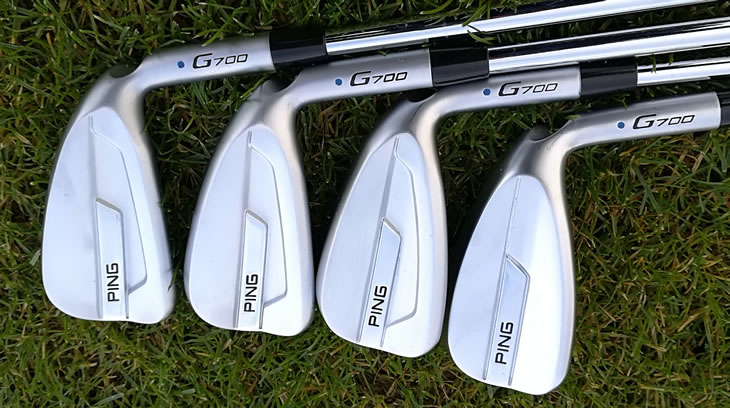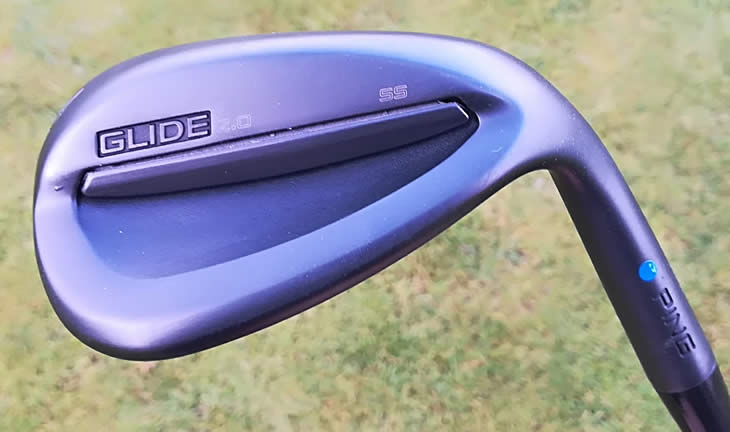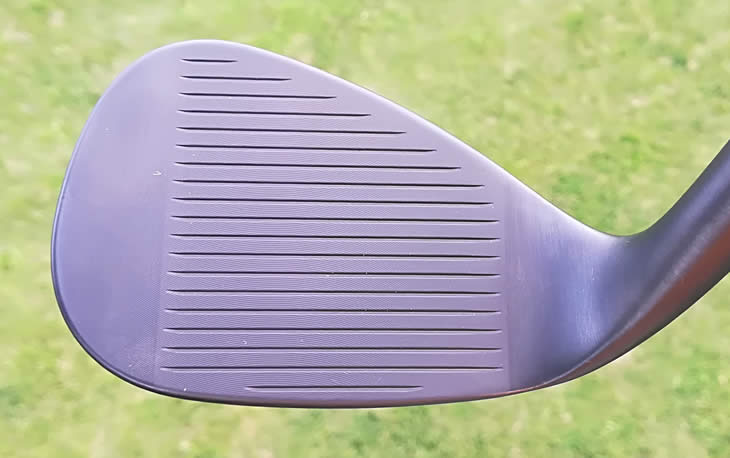Ping recently extended their G400 driver range and added a new hollow G700 iron so I met up with Marty Jertson, Director of Product Development to find out why.
Hi Marty. You've got another G400 driver that's just come out which is the G400 Max, so what's the difference between this one and the one you launched previously?
Yeah, so with the G400 Max driver we're on a mission to make the straightest driver we've ever designed.
Straightest driver ever?
Ever. And if you're sceptical you just go out and demo it and you won't be disappointed. So what this does in the context of the overall G400 family is the Max driver gives you distance through the forgiveness of the head.

So now, the G400s are 445cc, the Max is 460cc, so the head shape's a little deeper front to back and we've putting twice as much tungsten right here at the boundary and it wraps around, so the CG is substantially further from the face and the inertia is through the roof, off the charts, so 9900 g/cm2 combined heel-toe top bottom inertia basically it means there are no mis-hits with this club.
Your drivers have always had quite a deep low CG anyway, so was it a quite a challenge getting it further back or does the extra head size make it easier to do that?
No, it was a challenge and it's the head size combined with all the discretionary weight savings from a lot of our technologies. For example the Dragonfly technology down to seventeen thousandths of an inch, super thin, so this saves a
lot of weight, the forged T9S face saves a lot of weight, so we can take the weight savings, even our adjustable hosel
is superthin and light, and we can concentrate all that mass really far back combined.
So yeah it's a challenging thing to do, but we feel like all the hard work is worth it with what amateurs and tour players are seeing with how straight the driver flies.
Well that's it, I mean this is really for all levels of player really, isn't it?
Yeah in even our first couple of weeks on tour we've had a lot of these in play really because they enjoy the freedom that comes knowing that you don't have to swing it perfectly and let's face it, in today's age you know the rewards and statistics are showing if you can hit it further and have a low percent offline, or degree of accuracy, you're going to score better.
But if this is forgiving because of the MOI, where does it put things like the the SF Tec driver because obviously that is there for forgiveness as well isn't it?

Yeah a great question. So there's this is kind of forgiveness through the MOI, the G400 driver is forgiveness through speed, then you also have the fitting optimization and that's a big key.
So our SFT driver where the tungsten weighting is a little more in the heel, it's a little lighter swing weight, that one's still going to turn over the easiest. So if you're right-handed player you kind of fight the miss to the right, the SFT is still a good place to start.
Then we have the low spin LST and that's a really good driver if you tend to just spin it too much, maybe your swing patterns they hit down on a little bit and you want to reduce your spin characteristic to optimize your trajectory, so within this family now we have some great options.The SFT is going to turn over the easiest, then the Max, then the G400, then the LST from a left-right biasing standpoint.
OK, so would this be a higher spinning driver then if you were talking about the LST being for high spin players?
We would kind of categorize this and the G400 kind of medium from a spin standpoint. We've still been able to get a lot of our Tour players into this, but I think your everyday player this is optimized kind of right in the sweet spot where the LST's more on the low end.
OK. All right let's go down the bag here, because the other product you've just brought out is this G700 iron. Is this the first time you've done a hollow iron?
Yeah. It's where we're bringing like a metal wood-like construction. I mean we've made like a G400 Crossover club so it's kind of an iron kind of a Crossover. We've had a driving iron type thing, but this is the first time through the whole set all the way up through the sand wedge. This has a metal wood like construction built for maximum flex out of the face.

So it's really a speed thing, or is it a forgiveness thing? You're going to say both, I know you are?!
You, know, it's speed first! It's speed first and then you get some forgiveness because of just how hot the face is.
So what you're going to trade off with this iron as compared to say our G400 iron, that is G400 is distance with a lot of distance control or precision. This one just has so much distance that you're going to gain some of that forgiveness from the amount the face flexes around the face, so this is more like hitting a driver you know, with an iron and, you know, I think a lot of people might be wondering why is that good to hit your irons far.
The reason why is if you can hit an 8-iron into the green instead of a 6 or 7 you're going to hit that closer to the hole because you have a shorter club with more loft and you're gonna hit it closer to hole. You get some forgiveness from the geometry of the face delivery angles and stuff like that to throw in there. So anytime you can in an 8-iron instead of a 6 you're going to hit it closer.
Were there any particular challenges you had to get through to make this hollow iron rather than the cast irons you've done in the past?
I think the big thing is selecting the right materials. The face material we're using is a maraging C300 and we really utilized all of our learnings that we had with developing the G400 fairway wood and hybrid that also utilize this maraging steel.

The material is really useful because it's strong and flexible at the same time and again that's kind of a very unique combination.
And then geometric challenges with trying to meet the sweet spot of an iron that goes far and high. There's a lot of distant irons in the market, no doubt about it, the irons that are kind of chasing distance. What this iron does that is absolutely unique is towering distance. Players will be absolutely amazed by how high this goes. And it's not spinning.
I was going to say, is this a lower spinning iron then?
It's a low spin high trajectory and you might be wondering how we did that? It's how the face moves during the impact, so very high ball speed, launch is very high. It kind of launch flexes so the face top rail relaxes during the impact, similar to our G400 iron and then when you get that extra ball speed it's allowing everyday players to have the tour trajectory in their iron.
Super high, but not spinning a ton.

So where is that going to sit relative to the G400 iron?
The G400 is going to deliver a kind of distance, but with a little more precision in terms of distance control, but if you're a player out there that kind of wants to get one less club into the green, you want to have a little more fun playing golf, you might tend to come up a little short with your irons, start with the G700 iron.
So down to the bottom of the bag now and we have a Glide 2.0 Stealth wedge which has got a darker finish now. So what made you go for a black finish?
So we were kind of inspired a little bit by our tour players who are looking for a wedge that looked a little more compact and on a sunny day could eliminate some glare, especially when you're shot making around the greens and with the face open.
They are also were asking us to come out with a wedge that felt a little more muted during the impact. So with the Glide 2.0 Stealth we switched to 8620 carbon steel, which because it's a little softer delivers that a little more muted feel during the impact.

Is this something you see consumers asking for as well? What proportion of wedges will be black versus the chrome that you do?
Well, we think it's gonna have a pretty high demand and so we're offering all of our lofts and grinds in the Stealth finish as well as our Hydropearl finish. So yeah the early feedback from these wedges has been very positive and so we're pretty optimistic about the Stealth finish.
We also took this chance to make a few upgrades to the grooves too.You see that we have no paint fill in the bottom groove, that actually gives a little more volume to displace the moisture during the impact. This is the details!
We like the details! Give us the details!

And we have this half groove at the bottom of the high lofted clubs to add a little more camber to it.

Again, just like we had one more tread to your tyres to displace some moisture, so spin ratios have been phenomenal and we've had significant tour adoption in the Stealth finish and it could be as simple as, hey, I like the look of and the size of
the Chrome or I like the look and size of the Stealth.
Thank you Marty
Ping G400 Max Driver Review
Ping G700 Irons Review
Ping Glide 2.0 Wedge Review
More from Ping